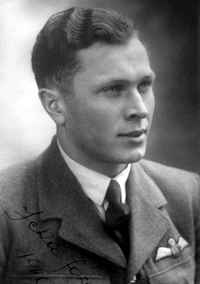Józef Jeka
Józef Jeka | |
|---|---|
 | |
| Born | 6 April 1917 Tupadły, German Empire (present-day Poland) |
| Died | 13 April 1958 (aged 41) Manado |
| Allegiance | |
| Service | |
| Years of service | 1937-1958 |
| Rank | squadron leader |
| Unit | Polish 141st Fighter Escadrille No. 238 Squadron RAF No. 306 Polish Fighter Squadron No. 308 Polish Fighter Squadron No. 316 Polish Fighter Squadron |
| Commands | No. 306 Polish Fighter Squadron |
| Battles / wars | Polish Defensive War, World War II |
| Awards | Virtuti Militari; Cross of Valour; Cross of Merit with Swords (Poland); Distinguished Flying Medal; 1939–1945 Star; France and Germany Star; Defence Medal (United Kingdom); War Medal 1939–1945; Air Force Medal for War 1939-45 (Poland) |
Józef Jeka was a Polish fighter ace of the Polish Air Force in World War II with 8 confirmed kills.
Biography
Early years
Józef Jeka was born in Tupadły (present-day it is part of the town Władysławowo). He was the son of Antoni and Agata Mudlaff.[1][circular reference] Józef's father was a Polish independence activist.[2][circular reference] Two Józef's brothers, Alfons and Stanisław belonged to the Pomeranian Griffin.
On 1 August 1937 Józef Jeka entered the Non-Commissioned Officer's School for minors. Then he participated in a course in aircraft maintenance. After completing his flying training[3][circular reference] and then a fighter pilot course, he was assigned to Polish 141st Fighter Escadrille.
World War II
During the September Campaign Jeka flew a PZL P.11. After the Soviet invasion of Poland he crossed the border with Romania, where he was interned. He escaped to France via Yugoslavia and Greece, on 23 October he arrived in Marseilles.
On 23 February 1940 he came to England. After training in Blackpool and Carlisle[4][5] Jeka was sent to No. 238 Squadron RAF. He shot down his first plane on 15 September 1940. He became an ace on 7 October when he downed a Ju 88 (it was his 5th victory). On 5 October Jeka himself was shot down and wounded. He was hospitalized till 15 November in Shaftesbury. From 15 November 1940 to 15 December 1941 he flew in No. 306 Polish Fighter Squadron and destroyed two Bf 109. From December 1941 to March 1942 Jeka was an instructor in No. 58 Operational Training Unit based at RAF Grangemouth. He came back to his squadron on 25 May 1942.
On 9 December 1942 he entered officers school. Named porucznik he was ordered to No. 308 Polish Fighter Squadron, he also served in No. 316 Polish Fighter Squadron. On 21 May 1944 Jeka was hit by flak over France and had to jump with a parachute. Fortunately he managed to hide thanks to the French Resistance. Two months after the front reached his place of residence and Jeka returned to his unit. On 25 May 1945[6] he became commander of the 306 squadron.
On 31 December 1949 Jeka ended his service in the Polish Air Force.
Cold War
After the war ended Jeka stayed in the RAF and served in Germany as a soldier of the occupation forces. He married a British woman and had a daughter who he never met.[citation needed] In Germany he received an offer to work for the CIA, Jeka willingly accepted as an avowed anti-communist. Since 1950 he collaborated with British and American intelligence, he flight-tested the aircraft U-2 and completed missions over Central and Eastern Europe.[7][circular reference] He was considered as a candidate to steal a soviet MiG-15. The mission was cancelled, when on 5 March 1953, another Polish pilot Franciszek Jarecki landed his MiG on Bornholm.
In the 1950s Jeka took part in the indonesian conflict where he died in an aircraft crash, flying a B-26B, on 13 April 1958.
Awards[8][circular reference]
![]() Virtuti Militari, Silver Cross
Virtuti Militari, Silver Cross
Cross of Valour (Poland), four times
![]() Cross of Merit with Swords (Poland)
Cross of Merit with Swords (Poland)
![]() Distinguished Flying Medal
Distinguished Flying Medal
![]() 1939–1945 Star
1939–1945 Star
![]() France and Germany Star
France and Germany Star
![]() Defence Medal (United Kingdom)
Defence Medal (United Kingdom)
![]() War Medal 1939–1945
War Medal 1939–1945
![]() Air Force Medal for War 1939-45 (Poland)
Air Force Medal for War 1939-45 (Poland)
Military promotions[9][circular reference][10][circular reference]
Polish Air Force
- szeregowy - 1 August 1937
- starszy szeregowy - 1 April 1938
- kapral - 30 June 1939
- plutonowy - 15 October 1941
- podporucznik - 1 November 1941
- porucznik - 1 March 1943
- kapitan - 1 January 1946
- major - 15 August 1947
Royal Air Force
- Sergeant - 15 August 1940
- Pilot Officer - 1 November 1941
- Flying Officer - 1 October 1942
- Flight Lieutenant - 1 November 1943
- Squadron Leader - 25 May 1945
References
- ^ pl:Plik:Józef Jeka, akt zgonu brata.jpg
- ^ pl:Plik:Józef Jeka, życiorys 1.jpg
- ^ pl:Plik:Józef Jeka, życiorys 1.jpg
- ^ http://www.mojawyspa.co.uk/artykuly/25545/Aukcja-pamiatek-polskiego-bohatera
- ^ https://www.telegraph.co.uk/news/uknews/6684997/World-War-Two-heros-memorabilia-to-be-auctioned.html
- ^ http://www.sww.w.szu.pl/index.php?id=polska_306_dywizjon
- ^ pl:Plik:Józef Jeka, życiorys 3.jpg
- ^ pl:Plik:Józef Jeka, przebieg służby 6.jpg
- ^ pl:Plik:Józef Jeka, życiorys 2.jpg
- ^ pl:Plik:Józef Jeka, życiorys 2.jpg
Further reading
- Biszop (12 November 2010). "As i agent" (in Polish). p. 1. Archived from the original on 15 November 2012. Retrieved 16 November 2010.
- Biskup, Mateusz (13 November 2010). "POLSKIE SKRZYDŁA: As i agent" (in Polish). p. 1. Archived from the original on 17 November 2015. Retrieved 17 November 2010.
